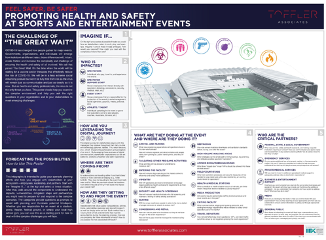Soft Targets and Crowded Places: Security & Resilience in a Socially-Distanced World

Over the summer, we witnessed the tentative return of professional sports across the globe. In reemerging, each league devised innovative ways to mitigate the risk of COVID-19: Some are playing in empty stadiums, others brought their teams into a “bubble,” and some are even allowing for limited (and not-so-limited) in-person fan experiences. As we’ve anxiously watched each of these approaches unfold, one thing has become overtly clear: soft targets and crowded places mean protecting the stakeholders at risk in this bustling ecosystem. Planning is key. Planning with foresight is a game changer.
Since the emergence of the pandemic, Toffler Associates has been collaborating with the Innovation Institute for Fan Experience (IIFX) to lead a sports and entertainment task force of health and safety, security, and medical leaders across the industry.
Working through various issues with the task force experts, two things became increasingly clear:
- While COVID-19 remains a threat element in any “return to work/play/spectate” scenario, so do other threats;
- The pandemic creates a new socially distanced, contagion-limiting baseline for sports and entertainment events that impact nearly all aspects of security and resilience planning.
In such complex environments, it is easy to have blind spots.
For safety, security, and resilience professionals to update or create security and resilience strategies with a new operational baseline and layered threat situations (pandemic+threat2), we have found that scenario planning is the most effective approach to shine a light on those blind spots. From identifying new threats and recognizing mitigation requirements to understanding the complex stakeholder ecosystems needed for planning and response, meticulously going through pandemic+threat2 scenarios highlights what is needed in today’s unique environment.
Scenario planning accelerates the return to work, play, and spectate
Our work with the task force emphasized the importance of conducting integrated scenario planning exercises with leadership, partners, and stakeholders. The challenges faced in any “return to” scenario are not the sole responsibility of the security or resilience departments or the medical department; rather, to safely bring people back to these soft targets and crowded places, we need to take an interdisciplinary approach to scenario planning. To that end, Toffler Associates and IIFX created a graphic scenario planning tool for the task force’s sports and entertainment stakeholders.
The tool serves as a starting point for pandemic+threat2 scenarios to develop “return to” plans and protocols. It helps any organization understand the relevant components in the complex ecosystem and the journey each stakeholder takes when experiencing their own “return to” situation, which allows security and resilience teams to look into the future with a shared understanding and a shared lexicon.
Define the scenario environment to set the stage
Set the strategic landscape for your stakeholders and make sure everyone has a shared understanding of the complex, pandemic-based environment. Areas around the country and the world are opening and closing at varying rates with different – and competing – policies. What’s the scope of the scenario? Who are the individuals involved? What do “safety” and “security” mean to them?

These five steps follow:
Step 1: Imagine If… Define the scenario threats; i.e., the pandemic+threat2 situation. Select one or more of the threat types that would be concurrent with the baseline COVID-19 threat. For example, social distancing protocols run smoothly until there is a fire, extreme weather event, or active shooter. What combination of threats “break” your current plans?
Step 2: Who is Impacted? Identify the stakeholders involved in the scenario and build personas. For the task force, we identified four persona categories: Spectators, Spectator Support Staff, Event Staff, and Talent. Your company and organization will have different stakeholders (e.g., employees, students, customers, faculty, patients) but understanding who they are and why they are coming together helps you understand their needs and risk profiles.
Step 3: What are their journeys? Whether people are following purely physical or digitally augmented journeys, locations matter. It’s important to understand where your stakeholders are coming from and how they are getting to your venue. Different start/end locations, different routes, and different modes of transport carry much different risks.
Step 4: What are they doing and where are they doing it? The vulnerabilities will be unique by business, location, and countless other factors; however, some example questions are included related to sports and entertainment events. Take the time to work with your team – from security to facilities to guest services – to map where your customers/employees/students/fans/guests travel in a venue and ask what are the specific threats and resilience requirements of specific areas.
Step 5: Who are the critical partners? The ecosystem is complex, that’s why understanding key internal and external partners is one of the most common blinds spots we see. Whether it’s suppliers, local first responders, or the finance department, identifying and including them in your scenario planning is essential. The more all parties share potential threats and planned responses, the better they can integrate and advise. What other groups of people do you need to communicate with to set expectations?
Applying scenario planning to other soft targets and crowded places
While the tool was developed for the sports and entertainment industry, the concept, steps, and considerations can be broadened to almost any other soft target situation. The stadium could be replaced by an office building, factory, retail shopping district, hospital complex, university campus, or other physical location where people congregate. The prompts and process to think about and prepare for other pandemic+threat2 scenarios follow the same framework. The scenario planning concept, the process described above, and the tool we developed are not exclusively beneficial to the sports and entertainment industry; all organizations can use this approach to ensure the protection of their stakeholders and assets.

 About the Authors
About the Authors